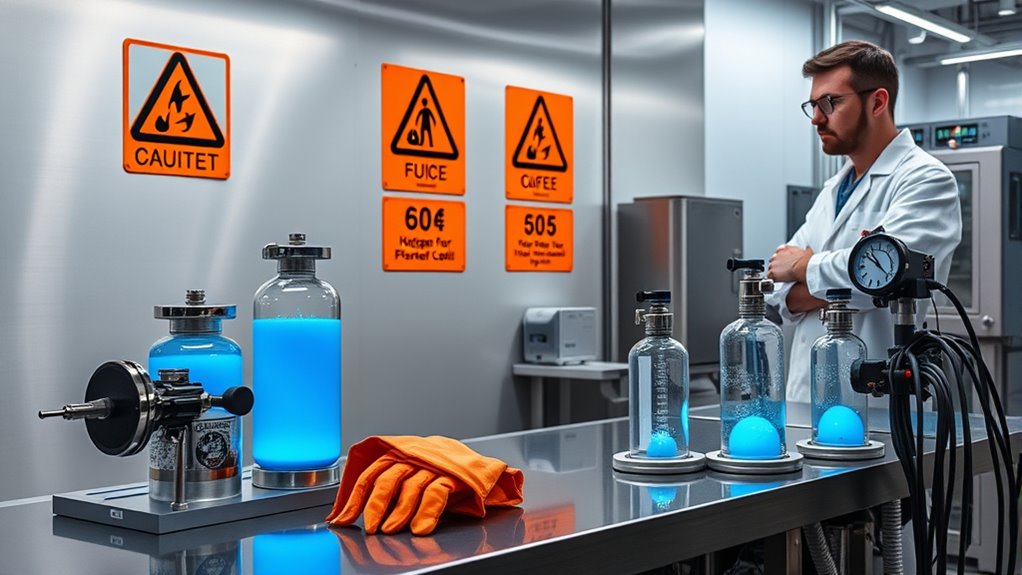To guarantee safety with hydrogen power, you must follow strict protocols for storage, handling, and transfer. Keep containers in compatible, well-maintained conditions and use proper ventilation to disperse leaked gas. Avoid ignition sources and conduct regular leak detection checks. Always wear appropriate protective gear and stay trained on emergency procedures. Proper safety measures can prevent accidents and explosions. Continue exploring these guidelines to fully understand how to operate hydrogen systems safely.
Key Takeaways
- Regularly inspect storage systems for leaks and weak points, ensuring proper maintenance and compatible materials.
- Use proper ventilation and leak detection systems to promptly identify and disperse hydrogen leaks.
- Keep ignition sources away, employ explosion-proof equipment, and ensure all tools are properly grounded.
- Implement strict handling protocols, including safety checks, accessible fire extinguishers, and minimized spill activities.
- Train personnel thoroughly on hydrogen risks, safety procedures, and emergency response, and ensure safety gear is readily available.

Are you aware of the safety measures necessary when working with hydrogen power? Understanding the risks involved is essential to prevent accidents and guarantee a safe working environment. Hydrogen is a versatile and clean energy source, but it comes with specific hazards that must be managed carefully. One of the primary concerns is storage hazards. Hydrogen is a highly flammable gas that can easily escape through tiny leaks or weak points in storage containers. If these leaks aren’t detected promptly, the accumulated gas can reach dangerous levels, creating a significant risk of explosion. That’s why choosing the right storage systems is indispensable. Use containers made from materials compatible with hydrogen, such as certain metals or composites, and verify they are maintained regularly to prevent deterioration. Proper ventilation in storage areas is also indispensable to disperse any leaked gas quickly, reducing the chance of buildup.
Ignition risks are another critical aspect to contemplate. Hydrogen’s flammability range is broad, and it can ignite with very little provocation, even from static electricity or a small spark. To minimize ignition risks, keep all ignition sources away from storage and working areas. Use explosion-proof electrical equipment, and verify that all tools and machinery are properly grounded. When handling hydrogen, avoid open flames, smoking, or any activity that might generate sparks. Implement strict protocols for the transfer and dispensing of hydrogen to prevent accidental leaks or spills that could ignite. Always conduct thorough safety checks before starting any work with hydrogen, and keep fire extinguishing equipment readily accessible in case of emergencies. Additionally, understanding the flammability range of hydrogen helps in designing effective safety measures and detection systems.
Personal protective equipment (PPE) is also indispensable when working with hydrogen systems. Wear flame-resistant clothing, gloves, and eye protection to shield yourself from potential ignition sources or accidental leaks. Training is equally important—make sure everyone involved understands the specific risks and knows how to respond in case of a leak or fire. Regular safety drills help reinforce proper procedures and keep safety at the forefront of everyone’s mind.
Frequently Asked Questions
How Does Hydrogen Leak Detection Work in Safety Systems?
You rely on hydrogen leak detection systems that use strategically placed hydrogen sensors to monitor for leaks. These sensors detect changes in hydrogen concentration and send signals to leak detection algorithms, which analyze the data for signs of leaks. When a leak is identified, the system triggers alarms and safety protocols, helping you respond quickly and prevent accidents. Proper sensor placement and effective algorithms are vital for reliable leak detection.
What Are the Emergency Shutdown Procedures for Hydrogen Leaks?
Imagine a fire alarm blaring in a quiet room—that’s how urgent an emergency shutdown for a hydrogen leak feels. You activate emergency protocols swiftly, shutting valves and venting the system to contain the leak. Leak mitigation is your goal, so you follow clear steps to prevent hazards. Your quick response minimizes risks, ensuring safety as you work to stabilize the system and protect everyone nearby.
How Are Hydrogen Storage Safety Standards Evolving?
You’ll find that hydrogen storage safety standards are constantly evolving, driven by new storage regulations and improved risk assessment techniques. Manufacturers and regulators are tightening standards to address potential hazards, guaranteeing safer storage methods and materials. By staying updated on these changes, you can better implement safety measures, reduce risks, and ensure compliance. Continuous advancements aim to minimize accidents, making hydrogen storage safer for everyone involved.
What Training Is Required for Hydrogen Safety Personnel?
You need specialized training to become hydrogen safety personnel, including obtaining safety certification and understanding proper Personal Protective Equipment usage. Your training covers hydrogen hazards, emergency response, and safety protocols. By completing these courses, you guarantee you’re prepared to handle hydrogen safely, minimize risks, and respond effectively to incidents. Stay current with evolving standards to maintain your certification and keep your skills sharp, ensuring a safe working environment for everyone involved.
How Does Hydrogen Safety Compare to Other Fuel Sources?
Imagine a spark in a quiet garage—hydrogen ignition can happen quickly, making safety vital. Compared to other fuels, hydrogen requires stricter storage stability measures because it’s prone to leaks and ignitions. While gasoline’s flammability is familiar, hydrogen’s rapid combustion demands extra vigilance. You must understand these differences, handle hydrogen with care, and guarantee safety protocols are in place to prevent accidents and protect everyone involved.
Conclusion
By following these hydrogen power safety guidelines, you become the guardian of a new energy dawn, steering clear of hidden pitfalls like a lighthouse guiding ships through treacherous waters. Remember, safety isn’t just a rule—it’s your shield against sparks and shadows that threaten to ignite danger. Embrace these practices confidently, and you’ll guarantee that this powerful energy source shines bright and safe, lighting the way to a cleaner, safer future for all.









